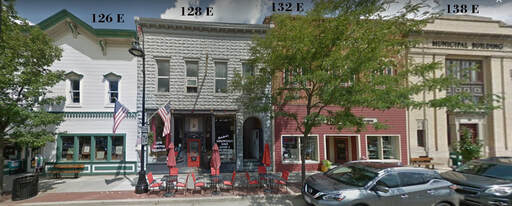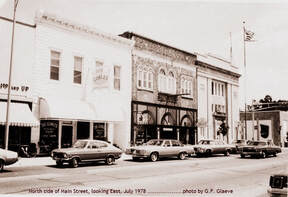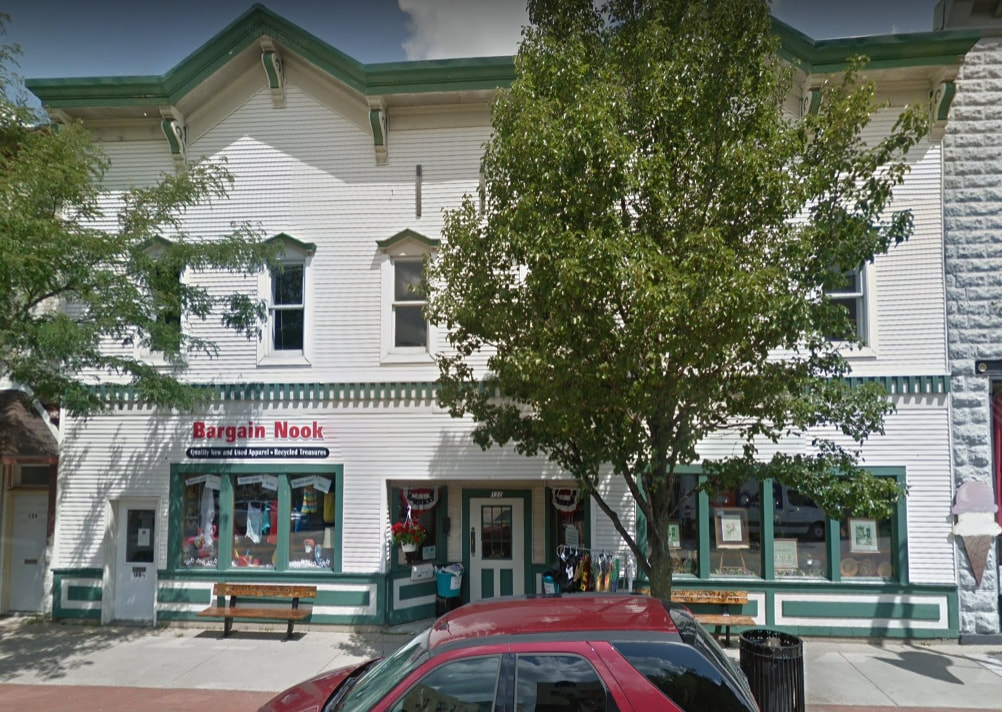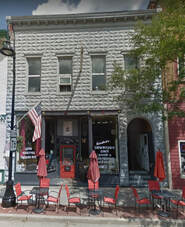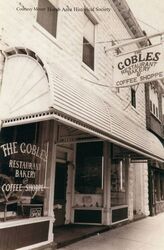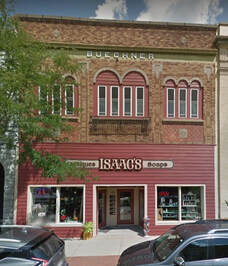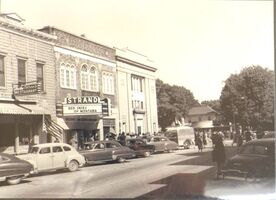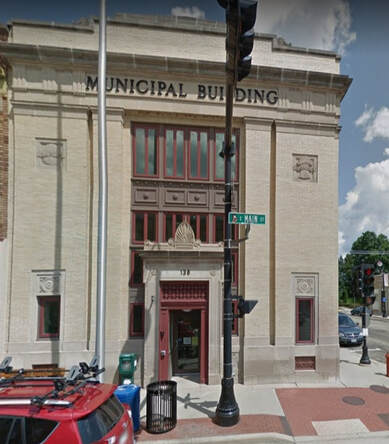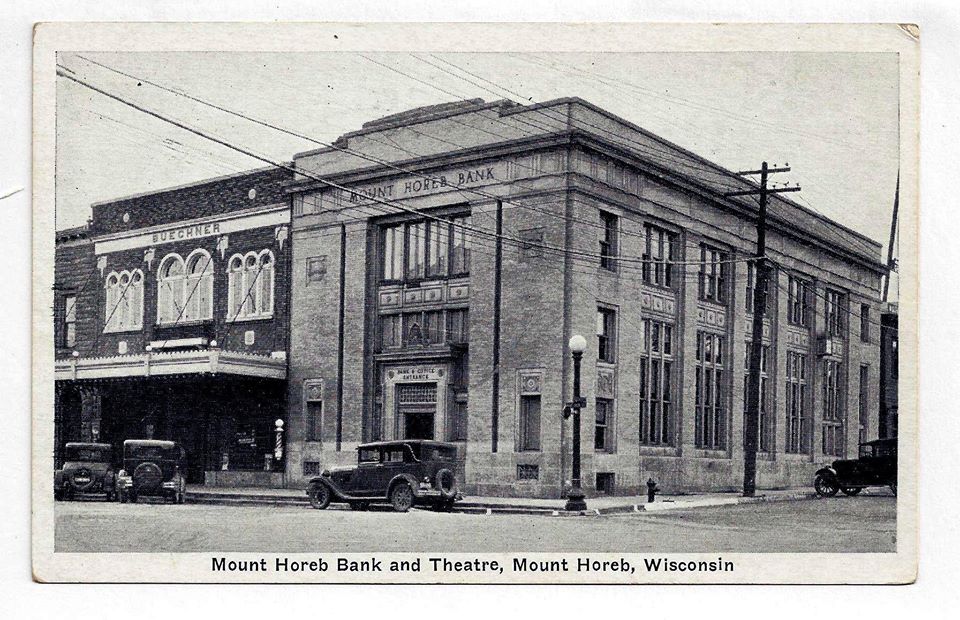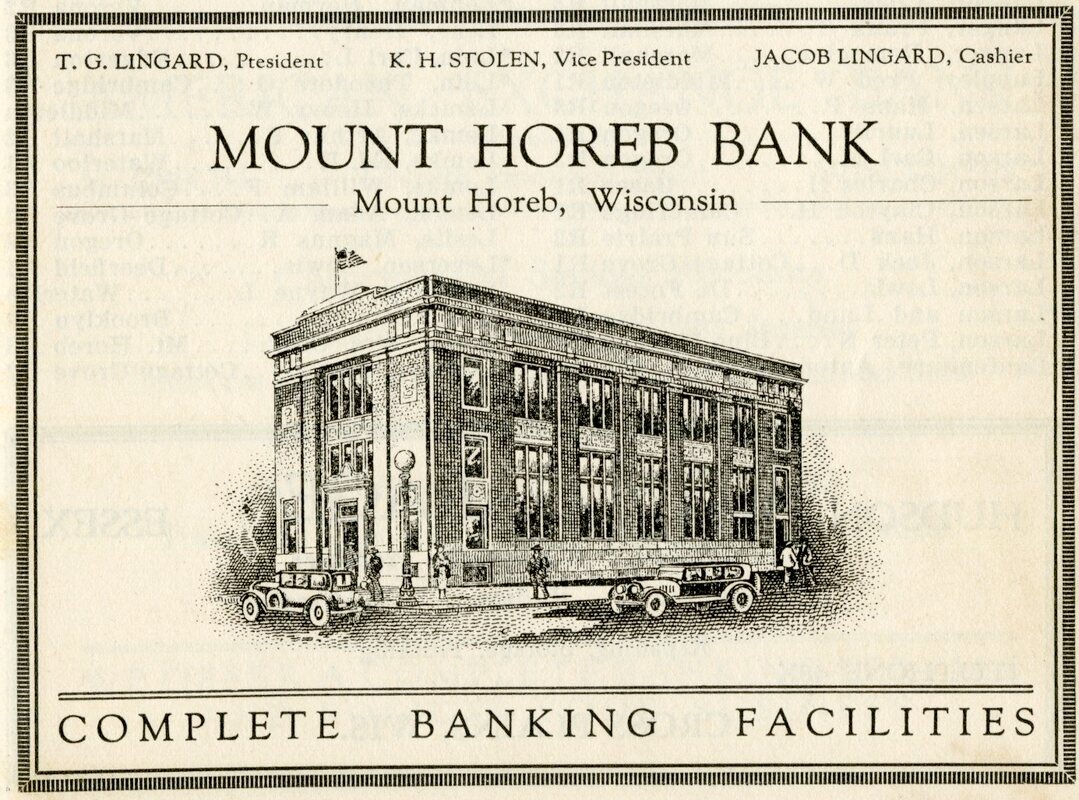126 East Main - 138 East Main Street (north side)
126 East Main Street (Andrew Thompson & Co. Furniture Store)
|
126 East Main Street
This frame Boomtown Front commercial vernacular building was erected for the Andrew Thompson and Company Furniture Store in two sections, the first in 1882 and the second in 1893 (Village of Mount Horeb Tax Rolls; Sanborn-Perris Map of Mount Horeb). The Thompson building retains its Italianate-influenced second-story window hoods, bracketed cornice and pedimented false front, although the storefront has been severely altered. An early twentieth century photo on file at the Mount Horeb Historical Society show two storefronts, each with a central recessed double-door entrance, and on either side of each entrance, a two-pane display window with one-pane transom and paneled wood kick plate, with a continuous simple classical storefront cornice running above both stores. In 1874, Andrew E. Thompson, a Norwegian, built a wagon shop and residence north of the present-day intersection of Springdale and Eighth Streets. Thompson also was the first undertaker in Mount Horeb ((The Mount Horeb Centennial Book, 1861-1961, p. 13). In 1882, Thompson had this building erected for his furniture store, wagon-making and undertaking business. In 1893, Thompson expanded the building, creating a public hall and lodging rooms on the second floor. Tore Fosshage and John Olson bought the building in 1897, and established their furniture and undertaking business in it. Fosshage and Olson also carried wallpaper, paints, window glass and shades. In 1899, the partnership dissolved, and Fosshage continued on his own. He was soon joined by his sons, Earl and Noel. Following Tore Fosshage's death in 1910, undertaking was discontinued. Wallace and Philip joined their brothers in the Fosshage Furniture store, which continued until at least 1928 (Wisconsin State Gazetteer and Business Directory). After the furniture store closed, the first floor was partitioned into two shops. Tenants over time included Parisey Variety, Evans Five and Dime, and Philip Hoff's Bar and Bowling. In 1954, Raphael Vasen removed the partition and opened a Ben Franklin Store in the building (Mount Horeb Presettlement to 1986, p 20). This property was owned by Andrew Thompson from 1882 until 1897, by Tore Fosshage and John Olson from 1897 until 1899, by Tore Fosshage from 1899 until 1910, by the Fosshage family and William Lohff from 1911 until 1916, by the Fosshage family from 1916 until 1928, by Fosshage and Gonstad from 1926 until at least 1935, and by Raphael Vasen from at least 1940 until at least 1980. Stephen Vasen has owned the property since at least 1985. The Thompson Furniture Store is not individually eligible for historic designation, but is a contributing element in the potential National Register Main Street Historic District, and the potential locally-designated Main Street Historic District. |
128 East Main Street (Thomas Ayen/Otto Olson Restaurant & Bakery)
|
128 East Main Street
This commercial vernacular building was erected by and for contractor Thomas Ayen in 1905. It is constructed of rock-faced concrete blocks, has a pressed metal cornice, and retains its original, or an early, storefront. The first tenants are unknown, but in 1911, Otto Olson opened a restaurant and bakery in the building. Olson previously had been the butter maker at the Mt. Horeb Co-operative Creamery. Olso operated the restaurant until he retired in 1943, his family continued the business until 1957. In the late 1970's Doug Goble bought the business, and changed the name of the restaurant to "Goble's." Jerry Thompson and Jerry Schubert bought the business in 1980, and Jerry and Judy Schubert have owned it, and operated it as "Schubert's," since 1986. The second floor housed an apartment, a banquet/meeting room, and in 1935, Walter Hopkins' barber shop. There was a buiding on this site prior to the existing one. From 1887 until circa 1900, this housed G.G. Mandt's paint shop, and was the site where he published the Dane County Sun, a weekly newspaper. It then housed Burchell's restaurant until 1905 (Mt. Horeb Presettlement to 1986, p.21). This property was owned by Thomas Ayen from 1904 until 1910, by Thomas Lingard from 1910 until 1914, by Otto Olson and the Olson family from 1915 until 1957, by Bert Frederickson from 1957 until at least 1975. Douglas and Nancy Goble owned the building during the late 1970's, selling to Bertson Associates (Jerry Thompson and Jerry Schubert) in 1980. The current owners, Jerry and Judy Schubert, have owned the property since 1986 (Village of Mt. Horeb Tax Rools). The Ayen Building/Olson Restaurant is individually eligible for designation as a Mt. Horeb Historic Site; it is also a contributing element in the potential National Register Main Street Historic District, and the potential locally-designated Main Street Historic District. |
132 East Main Street (Strand Theater)
|
132 East Main Street
This commercial vernacular brick building was erected to house the Strand Theater over a four-year period from 1922 until 1928. The second story of the building displays the influence of the Mediterranean Revival style with the grouped windows and running arches, the ornamental tile work beneath the windows, and the wrought iron balconet. Construction of the theater was begun for Fred Luder, Junior, in 1922, but was discontinued when he died in 1924. In 1928, Joseph Buechner bought the property and completed the theater. It opened March 9, 1929. Floyd Albert operated the theater from 1940 until it closed in 1969. Immanuel Lutheran Church (1955), and the Mount Horeb Evangelical Lutheran Church (1961) both held services in the theater while their own buildings were under construction. In 1975, Wallace and Shirley Kelliher [Keller] bought the building and converted it into an antiques store. Although ownership of the business has changed, the building still houses an antiques store as of 1996. Second-floor tenants over time have included barbers Millard Steyer, Walter Hopkins, Melvin Sale and Melvin Schwenn; the Christian Book Store; Milady's Beauty Shop; and Burns Photo Studio. There was a building on the site prior to the existing one. In this earlier building, James Gesme established his furniture store and undertaking business in 1894. Gesme had a series of partners in the furniture and undertaking business, but by 1905 had sold the furniture department to John De Fine. The Mount Horeb Auto Company, operated first by Elmer Hogan and Gilbert Gilbertson, and later by Fred Thousand and James Anderson, was located in the previous building from circa 1915 until erecting their own building at 203 West Main Street in 1917 (Mount Horeb Presettlement to 1986, pp. 21, 27; Wisconsin State Gazetteer and Business Directory). This property was owned by Fred Luder, Junior, from 1922 until his death in 1924, and by his estate from 1924 until 1928. Joseph Buechner bought the property in 1928, and sold it to Andrew Hustad in 1930. By 1940, it was owned by the Buechner Building Company. Floyd Albert owned the property from 1940 until 1975. Wallace and Shirley Kelliher [Keller] owned it from 1975 until at least 1986. The owner in 1996 was Wilkins. The Strand Theater is not individually eligible for historic designation, but is a contributing element in the potential National Register Main Street Historic District, and the potential locally-designated Main Street Historic District. |
138 East Main Street (Mt. Horeb Bank II/Municipal building)
|
138 East Main Street
This brick NeoClassical Revival building was erected for the Mount Horeb Bank in 1924-25, but has served as the Mount Horeb Municipal Building for more than 50 years, since 1943. The Bank/Municipal Building exhibits fine NeoClassical details, executed in stone, including the shouldered architrave framing the front door, an entablature with triglyphs and guttae, and decorative blocks representing dairying and farming. The Mount Horeb Bank was the first local bank and was founded in 1891. Herman B. Dahle was president, Thomas J. Lingard was the cashier, and Onon B. Dahle was the third stockholder (Mount Horeb Presettlement to 1986, p. 19). These three were the officers of the bank through 1903. Herman Dahle was president until at least 1919; Thomas Lingard was cashier until at least 1919. From at least 1921 until at least 1928, Lingard was president, and Jacob G. Lingard was cashier (Wisconsin State Gazetteer and Business Directory). The Mount Horeb Bank was previously located at 105 East Main Street (which see). This bank building opened May 2, 1925. The bank closed in 1932, and was absorbed by the Mount Horeb State Bank (100 South First Street). In 1942, the Village of Mount Horeb purchased the building for $12,000. Some improvements were made, and the Village offices moved into the first floor space. Commercial rental and public space was maintained on the second and third floors until 1984, when the building was extensively remodeled, and an elevator installed. Since that time, the Village offices (including the Police Department) have occupied the first and second floors, while the Mount Horeb Historical Society has occupied the third floor. Other second and third floor tenants have included Edna Sharer's Charm Beauty Shop, dentists Dr. Edward Mithus and Dr. Waldo Brager, attorneys Carl Danhouser and Martin Tollund, Ralph Dahle Insurance, and the public library. The post office was also located in the building from 1925 through 1934, when John Dysland was postmaster (Mount Horeb Presettlement to 1986, pp. 22, 55). Henry Eggers wagon-making shop was located in an earlier two-story building on this site from its construction in 1882 until at least 1887. The building housed John Dahlen and Louis Martin's harness shop, as well as a jewelry shop, from about 1893 until about 1904. In 1905, there was a restaurant in the earlier building, and in 1915, a billiard parlor. These may have been Martin Holum's businesses, as he switched from restaurant, to billiard parlor, to confectionary between 1901 and 1916 (Wisconsin State Gazetteer and Business Directory). This property was owned by the Mount Horeb Bank from at least 1920 until 1932, by the Mount Horeb State Bank from 1932 until 1942, and by the Village of Mount Horeb since 1942. The second Mount Horeb Bank is probably individually eligible for listing on the National Register and for designation as a Mount Horeb Historic Site; it is also a contributing element in the potential National Register Main Street Historic District, and the potential locally-designated Main Street Historic District. |

